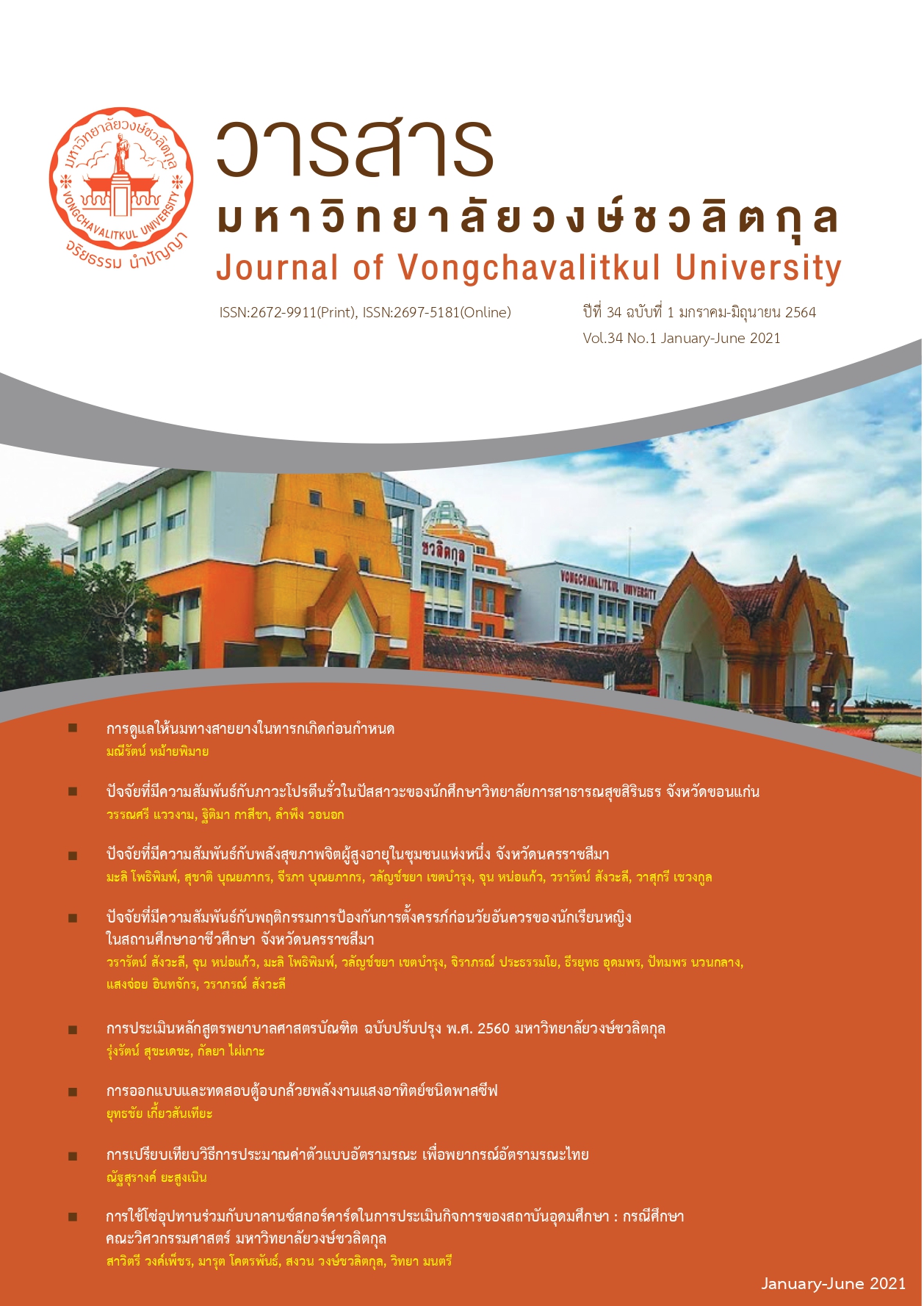Factors Related to the Resilience Quotient of the Older Adults Living in a Community, Nakhon Ratchasima Province
Main Article Content
Abstract
Objective: This cross-sectional analytical study aimed to examine 1) the older adult resilience quotient level, 2) the social support level, and 3) the factors related with resilience quotient of the older adults living in a community, Nakhon Ratchasima Province.
Method: Samples were 290 older adults living in 10 communities, Nong Kham Sub-District Health Promoting Hospital, Nong Rawiang Sub-District, Nakhon Ratchasima Province. The samples were recruited by using stratified random sampling method. A questionnaire was used for data collection. Data were analyzed using descriptive statistics including percentage, mean, and standard deviation, and chi-square for correlation.
Results: The results indicated that most subjects were male (61.38%), 60-69 years old (55.52 %), married (66.21%), completed secondary education (69.31%), had insufficient income (62 %), had underlying diseases (57.59%), alcohol drinking (12.07%) and smoking (21.38%). the elderly Resilience Quotient and the social support were at moderate levels (60.70%, 59.00%, respectively). Factors associated with Resilience Quotient were demographic data, which consisted of marital status, sufficient of income, underlying diseases, alcohol drinking, smoking and social support factors (p < .05). Therefore, health personnel should organize projects to develop the mental health vitality of the older adults especially in the area of social support.
Article Details
References
กัลยารัตน์ ธีระธนชัยกุล. (2563). อิทธิพลของแรงสนับสนุนทางสังคมและคุณภาพชีวิตที่มีอิทธิพลต่อความสุขผู้สูงอายุเขตกรุงเทพมหานคร ปทุมธานี และสมุทรปราการ. รายงานการวิจัย สาขาการจัดการคณะบริหารธุรกิจ มหาวิทยาลัยศรีปทุม.
กชกร ฉายากุล และ ภรณ์ทิพย์ ผลกระโทก (2563). ความสัมพันธ์ระหว่างปัจจัยบางประการกับพลังสุขภาพจิตของผู้สูงอายุที่ป่วยด้วยโรคเรื้อรัง ในเขตชุมชนชนบท จังหวัดนครราชสีมา. วารสารวิทยาลัยพยาบาลและการสาธารณสุขภาคใต้, 7(2), 127-137.
กมลมาลย์ วิรัตน์เศรษฐสิน. (2562). โรคไร้เชื้อบูรณาการสุขภาพ: แนวทางการปรับเปลี่ยนพฤติกรรมสุขภาพเพื่อวิถีชีวิตที่ยั่งยืน. กรุงเทพฯ: ธรรมสภา บันลือธรรม.
กรรณิกา เรืองเดช ชาวสวนศรีเจริญ, ไพบูลย์ ชาวสวนศรีเจริญ, และ เสาวลักษณ์ คงสนิท. (2562). ปัจจัยทำนายความแข็งแกร่งในชีวิตของผู้สูงอายุอาศัยในสถานสงเคราะห์คนชราพื้นที่ภาคใต้, วารสารสุขภาพจิตแห่งประเทศไทย, 27(2), 65-79.
ฉัตรฤดี ภาระญาติ, วารี กังใจ, และสิริลักษณ์ โสมานุสรณ์. (2559). ปัจจัยทำนายพลังสุขภาพจิตของ ผู้สูงอายุ. วารสารคณะ
พยาบาลศาสตร์ มหาวิทยาลัยบูรพา, 24 (2), 97-106.
ธโสธร ตู้ทองคำ. (2564). การพัฒนาสังคมผู้สูงอายุและบุคคลลักษณะพิเศษ. เข้าถึงได้จาก https://www.stou.ac.th/Schoolnew/polsci/UploadedFile/82427-15.pdf
นภัสกร จันทร์สอน, วารี กังใจ, และสหัทยา รัตนจรณะ. (2561). ปัจจัยทำนายพลังสุขภาพจิตของผู้สูงอายุโรคเบาหวาน.
วารสารการพยาบาลและสุขภาพ, 12(2), 12-24.
เพ็ญนภา กุลนภาดล และจุฑามาศ แหนจอน. (2558). การศึกษาและพัฒนาภูมิคุ้มกันทางใจวัยสูงอายุ โดยการบูรณาการกระบวนการมีส่วนร่วมของครอบครัวและเครือข่ายประชาสังคม. รายงานการวิจัยฉบับสมบูรณ์. มหาวิทยาลัยบูรพา.
มุกข์ดา ผดุงยาม และอัญชลี ช. ดูวอล. (2561). กลยุทธ์การฟื้นฟูพลังสุขภาพจิตในผู้สูงอายุ. วารสารพยาบาลทหารบก, 19(1), 66-73.
โรงพยาบาลส่งเสริมสุขภาพตำบลหนองขาม ตำบลหนองระเวียง จังหวัดนครราชสีมา. (2563). รายงานประจำปี2563. โรงพยาบาลส่งเสริมสุขภาพตำบลหนองขาม ตำบลหนองระเวียง.
โสฬวรรณ อินทสิทธิ์ และสิริกุล จุลคีรี บรรณาธิการ. (2563). เปลี่ยนร้ายกลายเป็นดี พลังสุขภาพจิต RQ: Resilience Quotient (พิมพ์ครั้งที่ 4). นนทบุรี: สำนักสุขภาพจิตสังคม กรมสุขภาพจิต กระทรวงสาธารณสุข.
สำนักงานสถิติจังหวัดนครราชสีมา. (2563). สถานการณ์ผู้สูงอายุจังหวัดนครราชสีมา พ.ศ.2562. เข้าถึงจาก http://statbbi.
nso.go.th/staticreport/page/sector/th/01.aspx
สำนักงานสถิติแห่งชาติ. (2561). สถิติประชากรศาสตร์ ประชากรและเคหะ. เข้าถึงจาก http://nkrat.nso.go.th/
index.php?option=com_content&view=featured&Itemid=435
อรุณลักษณ์ คงไพศาลโสภณ และรังสิมันต์ สุนทรไชยา. (2559). ปัจจัยคัดสรรที่มีความสัมพันธ์กับความเข้มแข็งทางใจของ
ผู้สูงอายุโรคซึมเศร้า. วารสารสุขภาพจิต. แห่งประเทศไทย, 30(2): 127-142.
อิงอร ลิ้มวัฒนาถาวรกุล, พรชัย จูลเมตต์ และนัยนา พิพัฒน์วณิชชา. (2562). ปัจจัยที่มีความสัมพันธ์กับความยืดหยุ่นของผู้สูงอายุโรคมะเร็งที่ได้รับยาเคมีบำบัด. วารสารพยาบาลศาสตร์ มหาวิทยาลัยสยาม, 20(38), 24-36.
American Psychological Association. (2021). What is resilience?. Retrieved from https://www.apa.org/topics/
resilience
Best, J. W. (1977). Research in Education. (3rd ed.). New Jersey: Prentice hall Inc.
Grotberg, E. (1995). A Guide to Promoting Resilience in Children: Strengthening the Human Spirit. Bernard Van Leer Foundation. Retrieved from http://www.bibalex.org/Search4Dev/files/283337/115519.pdf.
House, J. S. (1981). Measure and concepts of social support. In S. E. Cohen, & S. Syme (Eds.), Social support and health (pp. 83-108). Florida: Academic Press.
Krejcie, R. V., and Morgan, D. W. (1970). Determining Sample Size for Research Activities, Educational and psychological Measurement. 30, 607 – 610.
United Nations, (2018). Population Division. Online. https://www.un. org/development/desa/pd/


